
ęCERN Geneva |
CERN
The European Laboratory for Particle
Physics
High School Teachers 2000 Program
July 2, 2000 to July 21, 2000
|
Sister Mary Catherine Burns, S.U.S.C
Physics/Mathematics Teacher
Coyle and Cassidy High School
Taunton, MA 02780
USA |
PURPOSE The purpose of the program is to bring
together teachers from all members countries as well as a few from the United States
to learn about particle physics, about teaching it to young people and about the
contributions the field of physics makes to society in general. |
DETECTORS USED IN PARTICLE PHYSICS
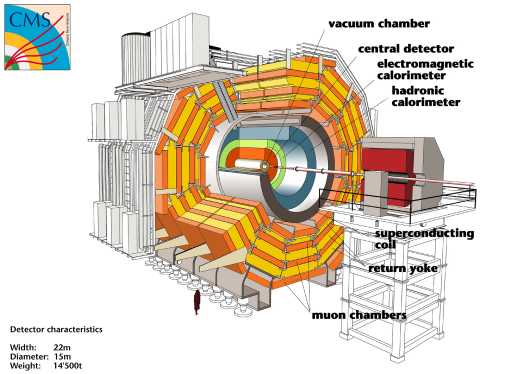
ęCERN Geneva
QUESTIONS AND
ANSWERS ABOUT DETECTORS
What is a detector used for in
particle physics?
Are there different kinds of
detectors?
What are the other ways you can categorize them?
What are the names of the kinds of detectors used at
CERN in the CMS ?
What is the CMS?
How do all the different kinds of detectors get arranged
in the CMS?
Is there any everyday thing that shows how all of
these different detectors work together to solve the problem of identifying particles?
How does a tracking detector work?
Where is there more informtion about
detectors on the web?
ANSWERS - Long and Short
What is a detector used
for in particle physics? TO IDENTIFY THE VARIOUS
PARTICLES
The detector is
a device that allows scientists to interpret signs left by the particles as they pass
through it. Different particles have different "signatures" or tracks by which
they can be recognized. As a result of using the detectors they can identify different
particles and discover properties of these particles.
The W
boson
The Top
Quark
The Z0
boson
Neutral current
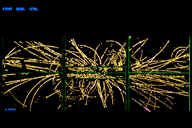
ęCERN Geneva |

ęCERN Geneva |
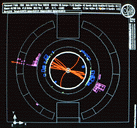
ęCERN Geneva |
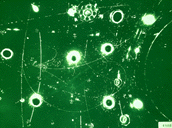
ęCERN Geneva |
Are there different
kinds of detectors? YES - FOR MEASUREMENT OF
POSITION AND OF ENERGY
Yes, there are. One
way to categorize them is by their function. Detectors do one of two things. They may
measure the position of passing particles, allowing scientists to reconstruct the path
they took and thus calculate the momentum of the particle or they may measure the energy
of the particle. This assists the scientists when they try to identify the particles and
may add to the information already known about the particle.
The table below gives you an
idea of how the different detector layers tell the scientist which particle left the
track. If you would like to test your understanding of this chart and how it works
click here.
| |
Positon |
Energy |
Energy |
Energy |
| |
Tracking
chamber |
Electromagnetic
calorimeter |
Hadronic
calorimeter |
Muon chambers |
| electron & positrons |
YES |
YES |
- |
- |
| photons |
- |
YES |
- |
- |
| pions |
YES |
YES |
- |
- |
| neutrons |
- |
- |
YES |
- |
| muons neutrinos |
YES |
YES |
YES |
YES |
What are the other ways
you can categorize them? BY DESIGN AND FUNCTION
Detectors can also be
categorized by their design and function. Properties such as charge, energy and momentum
need to be measured in different ways, hence the need for a variety of design in building
detectors.
What are the names of the kinds of
detectors that have been used or are presently being used at CERN ?
| The very first detector was the bubble
chamber. The scientists could use it to measure the position and the energy of the
different particles. In the middle
picture various particles are identified next to the track they made.
In the picture at the far right is Donald Glaser,
inventor of the bubble chamber. He received the Nobel Prize for his invention in 1970. |
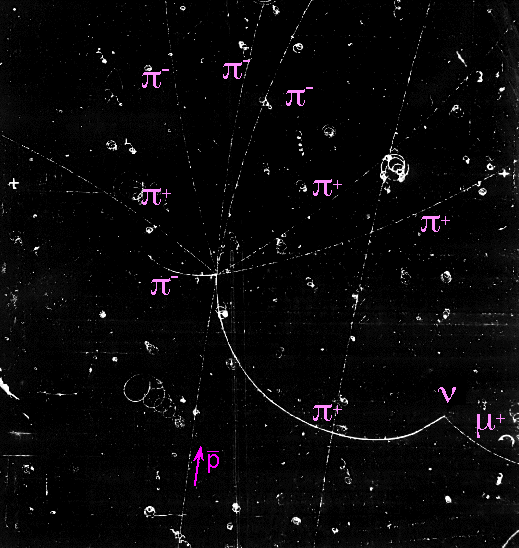
ęCERN Geneva |
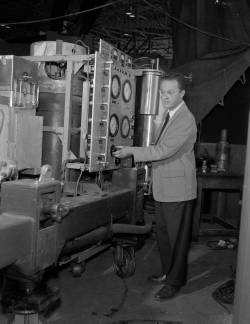
ęCERN Geneva |
Many new ones have been designed since then.
Tracking detectors include:
proportional wire chambers,
pixel detectors,
drift chambers,
silicon detectors,
gas microstrip chambers (or MSGCs),
and muon chambers.
SOME TRACKING DETECTORS
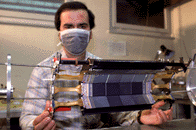
ęCERN Geneva |
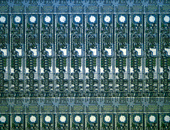
ęCERN Geneva |
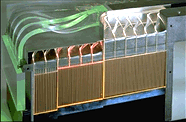
ęCERN Geneva |
| Silicon
Vertex detector |
Pixel detector readout chip |
Scintillator for particle detection |
Energy measuring detectors are called calorimeters.
There are two kinds: electromagnetic and hadron.
They are often named ECAL and HCAL.
SOME CALORIMETERS
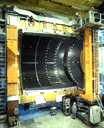
ęCERN Geneva |
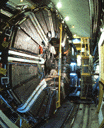
ęCERN Geneva |
| One half of the electromagnetic calorimeterof the OPAL
detector. |
Aleph Hadronic Calorimeter |
How does a tracking detector work?
Very simply - the curvature of the path can be measured and from that the
momentum can be determiined. Here is how it works:
The track is circular is circular so the force required to keep the particle moving on a
circular path is given by
F = mv2 / r
The force experienced by a particle in an electric field is given by
F = qvB
The field CAUSES the circular path, the EFFECT; so here it means that
qvB = mv2 / r
which simplified is mv = qBr = p
and
the conclusion is that the MOMENTUM, p, can be calculated since the charge, q, is known, the
induction of the electric field, B, is known and the radius, r, can be measured.
What is the CMS?
A HUGH DETECTOR BEING BUILT AT CERN
The CMS is a large very modern detector being built at CERN that
will be made up of many small detectors of all kinds. It will have 15 million
individual detector channels. With the help of powerful computers it will be capable of
recording any interesting collision from among the 800 million collisions that occur each
second! It will store enough energy, 2.5 Giga joules, to melt 18 tons of gold. The CMS
detector itself will weigh about 12,500 tons.
|
How do all the different kinds
of detectors get arranged in the CMS?
LIKE AN ONION IN LAYERS GOING AWAY FROM THE
CENTER
If you think of an onion you have a good idea of this answer. The particle
comes in at the center of the detector. The first layer wrapped around the beam line
(as the opening left for the particle is called), are the pixel detectors. Going
away from the center the silicon detectors come next and then the gas microstrip
chambers. Continuing out from the center, the electromagnetic calorimeters are
placed next followed by the hadron calorimeters.
Is there any everyday thing that
shows how all of these different detectors work together to solve the problem of
identifying particles?
COIN SORTERS and SCREENS WITH DIFFERENT SIZE
HOLES
In fact there are a few. Consider a coin sorter. You drop a handful of coins into
the top of the sorter and they go each into its own cylinder. Another way you
might think about this is to put pieces of screening with different size holes above
one another. The screen with the largest holes goes on top and the one with the smallest
holes goes on the bottom. When a handful of stony soil is poured on top, the largest
stones are not able to get through the first screen. Each successive screen filters out
the next size stones.
Test of your ability to use the particle identification chart:
| |
Positon |
Energy |
Energy |
Energy |
| |
Tracking
chamber |
Electromagnetic
calorimeter |
Hadronic
calorimeter |
Muon chambers |
| electron & positrons |
YES |
YES |
- |
- |
| photons |
- |
YES |
- |
- |
| pions |
YES |
YES |
- |
- |
| neutrons |
- |
- |
YES |
- |
| muons |
YES |
YES |
YES |
YES |
ANSWER THE FIVE QUESTIONS - CLICK ON ANSWERS TO CHECK
1. This particle does not leave any track in the tracking chamber
but loses all of its energy in the electromagnetic calorimeter.
2. This particle goes through every layer of the detector and
comes out of it still with some energy.
3. This particle does not leave any track in the tracking chamber;
it loses very little energy in the electromagnetic calorimeter;
but it deposits the rest of its energy in
the hadronic calorimeter.
4. This particle leaves a track in the tracking chamber and
deposits all of its energy in the electromagnetic
calorimeter
5. This particle leaves a curved track in the
tracking chamber and deposits all of its energy in the electromagnetic calorimeter.
ANSWERS
Where is there more informtion about
detectors on the web?
CHECK OUT THE FOLLOWING SITES
NOTE: Links are active only if the site reference is colored blue;
otherwise you must type in the address yourself.
INFORMATION ABOUT DETECTORS:
a) http://www2.slac.stanford.edu/vvc/detectors/vertex.html
This is a large site
with a lot of information on many different aspects of detecting particles
b) http://public.web.cern.ch/Public/SCIENCE/lepcolexp.html
This is a great site to
get a close look at how a detector works
c) http://www.ph.rhbnc.ac.uk/publicity/masterclass/events/taunuqq.html
Visualization of
significant "hadronic" events, with links to others
GENERAL INFORMTION ABOUT PARTICLE PHYSICS:
e) http://www.fnal.gov/
f) http://www.fnal.gov/pub/fermilab_intro.html
g) http://www.fnal.gov/pub/hep_descript.html
h) http://www.fnal.gov/pub/electronic_game.html
ANSWERS
1. the photon
The photon is not charged so leavesno track in the tracking
chamber
| |
Positon |
Energy |
Energy |
Energy |
| |
Tracking
chamber |
Electromagnetic
calorimeter |
Hadronic
calorimeter |
Muon chambers |
| photons |
- |
YES |
- |
- |
2. the muon
| |
Positon |
Energy |
Energy |
Energy |
| |
Tracking
chamber |
Electromagnetic
calorimeter |
Hadronic
calorimeter |
Muon chambers |
| muons |
YES |
YES |
YES |
YES |
3. the neutron
| |
Positon |
Energy |
Energy |
Energy |
| |
Tracking
chamber |
Electromagnetic
calorimeter |
Hadronic
calorimeter |
Muon chambers |
| neutrons |
- |
- |
YES |
- |
4. either the electron or the positron
By the direction of the curvature the correct one can be identified
| |
Positon |
Energy |
Energy |
Energy |
| |
Tracking
chamber |
Electromagnetic
calorimeter |
Hadronic
calorimeter |
Muon chambers |
| electron & positrons |
YES |
YES |
- |
- |
5. a pion
| |
Positon |
Energy |
Energy |
Energy |
| |
Tracking
chamber |
Electromagnetic
calorimeter |
Hadronic
calorimeter |
Muon chambers |
| pions |
YES |
YES |
- |
- |
To return to where you were when you chose to take the
test click RETURN












